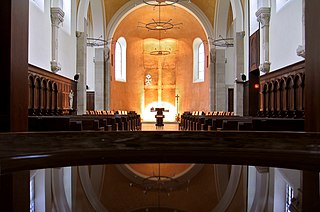
The Benedictines, officially the Order of Saint Benedict, are a mainly contemplative monastic order of the Catholic Church for men and for women who follow the Rule of Saint Benedict. Initiated in 529 they are the oldest of all the religious orders in the Latin Church. The male religious are also sometimes called the Black Monks, especially in English speaking countries, after the colour of their habits. Not all Benedictines wear black, however, with some like the Olivetans wearing white. They were founded by Benedict of Nursia, a 6th-century Italian monk who laid the foundations of Benedictine monasticism through the formulation of his Rule. Benedict's sister, Scholastica, possibly his twin, also became a religious from an early age, but chose to live as a hermit. They retained a close relationship until her death.

The Tironensian Order or the Order of Tiron was a medieval monastic order named after the location of the mother abbey in the woods of Thiron-Gardais in Perche, some 35 miles west of Chartres in France). They were popularly called "Grey Monks" because of their grey robes, which their spiritual cousins, the monks of Savigny, also wore.

The Abbey of Bury St Edmunds was once among the richest Benedictine monasteries in England, until its dissolution in 1539. It is in the town that grew up around it, Bury St Edmunds in the county of Suffolk, England. It was a centre of pilgrimage as the burial place of the Anglo-Saxon martyr-king Saint Edmund, killed by the Great Heathen Army of Danes in 869. The ruins of the abbey church and most other buildings are merely rubble cores, but two very large medieval gatehouses survive, as well as two secondary medieval churches built within the abbey complex.

Fleury Abbey (Floriacum) in Saint-Benoît-sur-Loire, Loiret, France, founded in about 640, is one of the most celebrated Benedictine monasteries of Western Europe, and possesses the relics of St. Benedict of Nursia. Its site on the banks of the Loire has always made it easily accessible from Orléans, a center of culture unbroken since Roman times. In 2010, the abbey had over forty monks led by the abbot Etienne Ricaud.

Jumièges Abbey, formally the Abbey of St Peter at Jumièges, was a Benedictine monastery. Its ruins are situated in the commune of Jumièges in the Seine-Maritime Departement of Normandy, France.

The Abbey of Saint-Victor is a former abbey that was founded during the late Roman period in Marseille in the south of France, named after the local soldier saint and martyr, Victor of Marseilles.

Ligugé Abbey, formally called the Abbey of St. Martin of Ligugé, is a French Benedictine monastery in the Commune of Ligugé, located in the Department of Vienne. Dating to the 4th century, it is the site of one of the earliest monastic foundations in France. The original abbey having been destroyed during the French Revolution, the current monastic community dates from 1853, and belongs to the Solesmes Congregation.

Lobbes Abbey was a Benedictine monastery in the municipality of Lobbes, Hainaut, Belgium. The abbey played an important role in the religious, political and religious life of the Prince-Bishopric of Liège, especially around the year 1000. The abbey's founding saint is Saint Landelin; four other saints are also connected with the abbey.

Le Bec-Hellouin is a commune in the department of Eure in the Normandy region in northern France.

La Trappe Abbey, also known as La Grande Trappe, is a monastery in Soligny-la-Trappe, Orne, France. It is known for being the house of origin of the Trappists, to whom it gave its name.

Ouche Abbey or the Abbey of Saint-Evroul is a former Benedictine abbey in Normandy, located in the present commune of Saint-Évroult-Notre-Dame-du-Bois, Orne, Normandy. It has been classified as a Monument historique since 1967 and is designated "classé".
The Abbey of St. Evre was a Benedictine, later Cluniac, monastery in Toul, France. Established in or just before 507, it was the oldest monastery in Lorraine and of great significance in the monastic and religious reforms in the Rhine and Moselle region of the 10th and 11th centuries.

Glanfeuil Abbey, otherwise the Abbey of St Maurus, was a French Benedictine monastery founded in the 9th century in the village of Saint-Maur-sur-Loire, located in what is now the commune of Le Thoureil, Maine-et-Loire.

Jouarre Abbey is a Benedictine abbey in Jouarre in the département of Seine-et-Marne.

Montiéramey Abbey is a former Benedictine abbey at Montiéramey, in France, in the department of Aube, in France. It was partly destroyed during the French Revolution; the surviving buildings are now private dwellings.
Bonneval Abbey may refer to:

The Abbey of St. Vincent, Laon was a Benedictine monastery in Laon, Picardy, northern France.

Fontenelles Abbey or Les Fontenelles Abbey was an Augustinian monastery in the former commune of Saint-André-d'Ornay, in the Vendée, France.























